From Ancient Greece to Modern Times: 40 Surprising Facts About the Olympics
Ancient Greece is the birthplace of the Olympic Games, a timeless monument to human athleticism and international harmony. The origins of the Games may be traced back to 776 BCE when they were held locally in the hallowed city of Olympia. The events included discus throwing and foot races. The Olympics have developed into a massive global spectacle that captivates spectators every four years in the modern period.
Through a historical trip, a wealth of unexpected facts about the Olympics are revealed, fusing the traditional with the modern. The Games were a show of religious devotion as well as a celebration of athletic skill in ancient Greece. Due to the tradition of justice and equality, athletes competed in the nude. The modern era’s Olympic flame represents the continuation of this old legacy.
When one reads through the chronicles of Olympic history, one comes across the Games’ sporadic disruptions, such as their suspension during World Wars I and II. At the event, there have been political declarations, boycotts, and disputes that reflect the convoluted geopolitical environment of the day. Through the addition of new categories and the development of sportsmanship norms, the Olympics provide an intriguing lens to study the millennia-long interdependence of human civilization and competition.
Here are the 40 Surprising Facts About the Olympics:
1. The First Ancient Olympic Games were held in 776 BC in Olympia
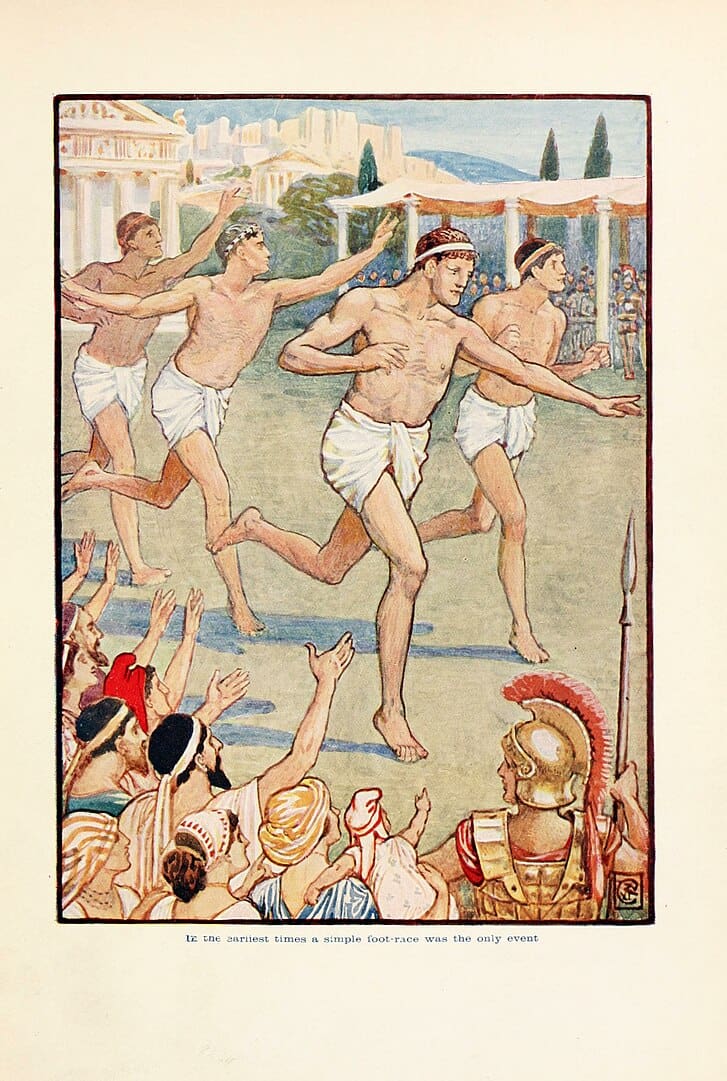
Walter Crane, Public domain, via Wikimedia Commons
A sporting tradition that would reverberate throughout history began when the Ancient Olympic Games were held in Olympia, Greece, in 776 BC. These ancient games included foot races, wrestling, and discus tossing and were devoted to the gods and physical prowess. Originating in the holy city, athletes from different Greek city-states fought for victory, beginning a tradition that would last for centuries and develop into the massive international event that is now known as the Olympic Games.
2. Olympics were Held Every 4 Years for Over 1,000 Years
Every four years, the Olympics were held in ancient Greece and served as a symbol of athletic brilliance for more than a thousand years. This long-lasting custom demonstrated unmatched athletic prowess and cultural cohesion between 776 BC and 393 AD.
But the Games came to an abrupt end in 393 AD when Theodosius I, the Roman Emperor, outlawed them because he believed they were incompatible with Christian doctrine. After a break of almost 1,500 years, the modern Olympic Games were revived in 1896, sparking the flame of international competition on a worldwide scale.
3. The Ancient Olympics had Fewer Events than Today with Mainly Athletic and Combat Sports

O. KuilleInternet Archive Book Images, No restrictions, via Wikimedia Commons
Compared to the Olympics of today, the ancient games had a far narrower range of competitions, with a strong emphasis on battle and athletics. These ancient Games, which took place in Olympia, Greece in 776 BC, featured events like chariot racing, foot races, wrestling, and boxing.
The emphasis on fighting skills and physical strength was a reflection of ancient Greek ideals. Unlike the large range of disciplines that exist now, the ancient Olympics established a tradition that has grown to include a variety of sports and athletic pursuits.
4. Married Women were Banned from Watching the Olympics of Penalty of Death
Unusual for history, married women were prohibited from competing in the Olympics up until the 4th century BC. Married women were forbidden from attending athletic events under threat of death during the ancient Greek Games, which were exclusively male-dominated events.
The rationale behind this ban is still entwined with the subtle theological and cultural aspects of that period, providing insight into the strict social mores that were in place at the time. As the Games changed over time, limitations progressively loosened, which helped the Olympics become a more varied and inclusive competition.
5. The winner of an Olympic Event was Crowned with an Olive Wreath
In the ancient Olympics, winning carried symbolic meaning beyond financial gain. Rather than monetary awards, the victorious athlete was given a sought-after olive wreath, which stood for both peace and honor.
This understated yet esteemed award, steeped in Greek customs, emphasized the inherent worth of sports accomplishment. The lack of monetary rewards highlighted the competitors’ dedication to perfection, highlighting the moral and spiritual qualities as well as the integrity of competition in the renowned ancient athletic event.
6. Ancient Olympians Competed Nude Supposedly to Honor the gods
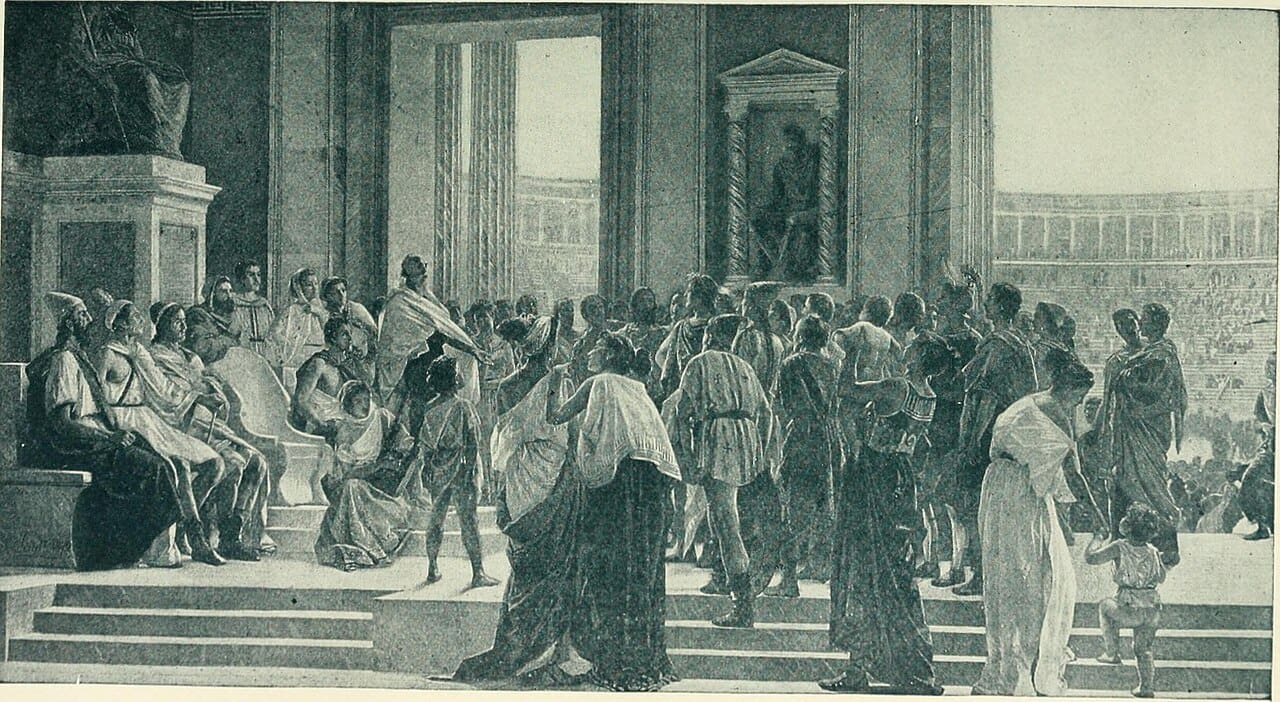
Giuseppe Sciuti, No restrictions, via Wikimedia Commons
Ancient Olympians competed in the nude, a unique ritual steeped in religious devotion and a display of unadulterated athletic might. This unclothed competition was thought to honor the gods and encourage equality and justice among competitors, having its origins in ancient Greece in 776 BC.
The competitors’ emphasis on physical prowess and their quest to exemplify the virtues of grace, power, and agility were highlighted by their lack of clothing. This distinctive feature of the classical Olympics revealed a deep affinity between athletics, religion, and the human body.
7. The Modern Olympics were Revived in 1896 and Held in Athens
The modern Olympics, a resuscitation of the antiquated athletic heritage, were first held in 1896 in Athens, Greece. This historic occasion, led by Pierre de Coubertin, signaled the return of international sportsmanship after an almost 1,500-year lapse.
Athletes from thirteen different countries came together at the Athens Games to celebrate the spirit of competition and to transcend national boundaries. This remarkable rebirth established the groundwork for the international athletic extravaganza that enthralls spectators every four years.
8. Women were Allowed to Compete for the First Time in 1900
Women competed for the first time in the Olympics in 1900 in Paris, although only in limited sports like tennis and golf. This was a huge step towards gender equality.
Although this modest entry was a start, it cleared the way for women’s participation in a variety of fields to gradually increase over the ensuing years. A more open and equal sports environment as well as more chances for female competitors were promoted by the event, which marked a turning point in Olympic history.
9. The Olympics have been Canceled Thrice in the Past due to World Wars
A symbol of world unity, the Olympic Games saw extraordinary disruptions during the turbulent World Wars era. The devastation caused by war forced the cancellation of the Games in 1916, 1940, and 1944.
The Olympic tradition was put on hold as a result of the destruction and turmoil caused by these international conflicts, which overshadowed the celebration of sportsmanship. Still, the Games’ tenacity persisted when they were brought back after the war, highlighting the spirit of perpetual international collaboration and the pursuit of peace via sports.
10. The 5 Olympic Rings Symbolize the Union of 5 Continents and Flag Colors
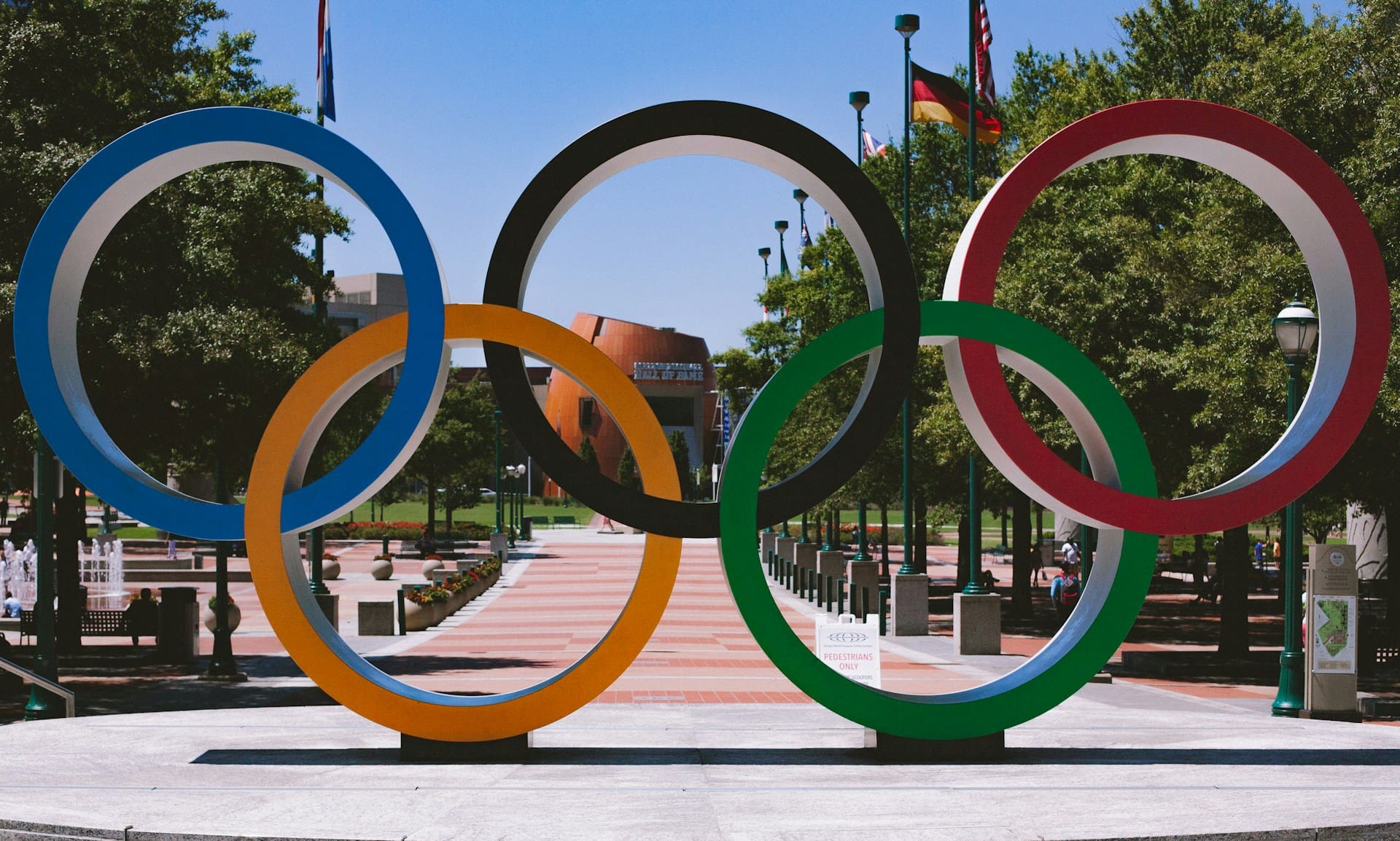
Photo by Bryan Turner on Unsplash
Sport has brought the five continents together, and the famous Olympic rings are a globally recognized symbol of this. Each ring in Pierre de Coubertin’s 1913 design represents a different color, green, black, yellow, red, or blue, which were selected to correspond with the colors seen in the flags of all participating countries.
With its strong symbolism, this insignia promotes unity and connections between people from different cultural backgrounds. The Olympic Games are global in scope, highlighting the common ideals of athleticism and global solidarity through their interconnecting rings.
11. Oscar Swahn is the Oldest Olympic Gold Medalist
The 60-year-old Swedish shooter Oscar Swahn made Olympic history in 1920 by being the oldest gold medalist, an incredible achievement at the Antwerp Olympics. Known for his accuracy with a gun, Swahn’s record-breaking performance in the team double-shot running deer event demonstrated not just his skill but also the enduring quality of sportsmanship. Swahn’s incredible triumph stands as a timeless tribute to the perseverance and talent of athletes of all ages.
12. Usain Bolt holds the Fastest 100m Sprint World Cup in Olympics

Fernando Frazão/Agência Brasil, CC BY 3.0 BR, via Wikimedia Commons
The legendary Jamaican sprinter Usain Bolt made history at the 2009 Berlin Olympics with an incredible display. Bolt broke the world record for the 100 meters in an incredible show of strength and speed, finishing in a whopping 9.58 seconds.
He became the fastest man on Earth thanks to his incredible athleticism and personality, which enthralled people all around the world. Bolt’s run for the record is a landmark event in sprinting history since it demonstrated unmatched quickness and agility.
13. Soviet Gymnast Larissa Latynina Holds the Most Olympic Medals
With the most Olympic medals won, Soviet gymnast Larisa Latynina is an unmatched powerhouse in Olympic history. Latynina accumulated an astounding eighteen medals between 1956 and 1964, demonstrating her exceptional ability and continued supremacy in artistic gymnastics.
Her accomplishment, which includes nine gold medals, remains a legendary moment in the history of the Olympics. Beyond her remarkable medal total, Latynina has left a lasting impact on the sport and served as an inspiration to gymnasts across the globe.
14. The US Won the Most Medals with over 2,500 Followed by the Soviet Union
With an astounding total of nearly 2,500 medals, the United States tops the Olympic medal count, demonstrating its legendary dominance in the Games. Germany, the United Kingdom, and Russia, the former Soviet Union’s successor, follow closely behind.
These countries have added to the rich fabric of Olympic history by continuously showcasing their superior athletic performance. These superpowers’ continued success is a testament to their dedication to athletic excellence and the worldwide influence of their athletes on the history of the most important sporting event in the world.
15. Skater Sonja Henie Won Three Gold Medals before becoming a Movie Star

Unknown (IOC Olympic Museum, Switzerland), Public domain, via Wikimedia Commons
Sonja Henie, a figure skater, made Olympic history in 1928, 1932, and 1936 by winning three gold medals in a row. Audiences were enthralled by the Norwegian prodigy’s grace and technique on the ice.
Henie proved her adaptability by making a smooth transition from the rink to the big screen, where she became a Hollywood movie star. Henie’s accomplishments on and off the rink, in addition to her physical attributes, cemented her status as a groundbreaking figure in 20th-century sports and entertainment.
16. The Melbourne Olympics Equestrian Events were held in Sweden due to Quarantine Rules
Due to Australia’s stringent quarantine regulations, horses were not allowed into the country for the equestrian disciplines, which presented an unprecedented logistical issue for the 1956 Melbourne Olympics. The remarkable decision was made to move the horse events to Stockholm, Sweden.
The adaptiveness of the Olympic organizers was demonstrated by this creative approach that guaranteed the inclusion of equestrian sports in the Games. Thus, the 1956 Melbourne Olympics stood out for their creativity in overcoming obstacles and producing a remarkable sports event on a worldwide scale.
17. Walt Disney Created the Official Olympic Mascot Abstract Figure Called Izzy
Walt Disney, the brilliant inventor, created the official mascot, Izzy, to bring his enchanted touch to the 1996 Summer Olympics in Atlanta. Izzy, an ethereal and whimsical figure, embodied the joy and celebration that characterized the Games.
Izzy is a memorable and distinctive mascot that adds to the Olympic tradition, showcasing Disney’s creative creativity. Despite receiving a mixed reception, Izzy is still a fascinating look into the relationship between entertainment and sports on the 100th anniversary of the modern Olympic Games.
18. Ernest Lundeen is the Youngest known Olympian who Competed as a Coxswain in Sailing
Ernest Lundeen became the youngest known Olympian, securing a special place in Olympic history. At the age of 12, Lundeen demonstrated remarkable skill as a sailing coxswain at the 1900 Paris Games.
His incredible performance at such a young age is evidence of the increasing diversity of athletes competing at the Olympics over time. Lundeen’s early foray into athletics adds a delightful and remarkable chapter to the extensive collection of Olympic tales and accomplishments.
19. Tokyo is the First Asian City to Host the Olympics Twice
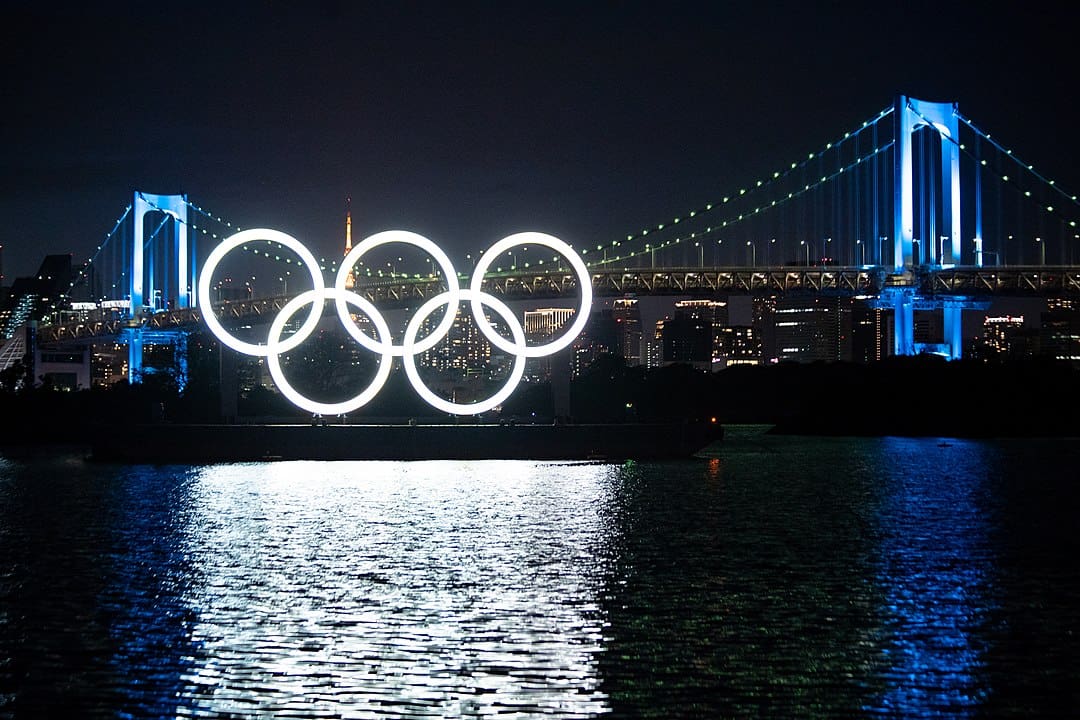
Dick Thomas Johnson, CC BY 2.0, via Wikimedia Commons
Tokyo became the first Asian city to hold the Olympics twice, marking a significant historical achievement. The world was first welcomed to the Japanese capital in 1964, and it made a lasting impression on the history of the Games.
A few decades later, in 2021, Tokyo took on the hosting duties once more, demonstrating its tenacity and dedication to the Olympic ideals. This double honor highlights Tokyo’s importance in the world of sports and its capacity to plan major occasions, adding to the Olympic Games’ lasting legacy in Asia.
20. Swimmer Michael Phelps has the Most Olympic Medals
The most decorated Olympian in history is swimming sensation Michael Phelps. From 2004 to 2016, Phelps competed in four Olympic Games and won an astounding 28 medals, 23 of which were gold.
His name will always be remembered for his incredible athleticism, commitment, and pool dominance. Phelps’s incredible accomplishment is proof of his lasting influence and the height of achievement in the world of competitive swimming.
21. The 2020 Tokyo Olympics were Postponed until 2021 due to the COVID-19 Pandemic
The COVID-19 pandemic’s widespread effects resulted in the historic postponement of the 2020 Tokyo Olympics, an extraordinary global event, to 2021. It was the first time that the Games had been postponed in Olympic history.
The choice made with athletes’ and fans’ safety in mind illustrated the unique difficulties the pandemic presented. The event was postponed until 2021 as a symbol of perseverance and a shared resolve to preserve the Olympic spirit in the face of extraordinary conditions.
22. The 5 Colored Olympic Flag was First Flown at the 1920 Antwerp Games

Makaristos, Public domain, via Wikimedia Commons
The 1920 Antwerp Games saw the introduction of the famous Olympic flag, which consists of five interlocking rings in the colors blue, yellow, black, green, and red. The rings, which were created by Pierre de Coubertin, represent how sports have brought the five continents together. Since then, this timeless symbol has come to symbolize the Olympic movement and the unity and brotherhood that characterize the international athletic competition, making a lasting impression on the colorful tapestry of Olympic history.
23. The Olympic Motto is Citius, Altius, Fortius
The three Latin words “Citius, Altius, Fortius,” which translate to “Faster, Higher, Stronger,” capture the spirit of the Olympics. The motto, which was first used by Pierre de Coubertin, represents the quest for greatness and human development.
These words, which have become a global rallying cry for athletes, are based on the idea that sports should motivate people to realize their full potential. The Olympic slogan captures the spirit of perpetual competition and the never-ending pursuit of excellence that characterizes this international athletic competition.
24. Simone Biles Won 4 Golds and 1 Bronze in Women’s Gymnastics at the 2016 Rio Olympics
At the 2016 Rio Olympics, Simone Biles won four gold medals and one bronze in an incredible feat of gymnastic skill. The American gymnastics sensation cemented her place as one of the best gymnasts of all time with her incredible performances in the vault, floor exercise, team, individual all-around, and bronze on the balance beam competitions. Biles’ remarkable accomplishments in Rio demonstrated her amazing talent, accuracy, and unrelenting commitment to the sport.
25. The Torch Relay was Introduced at the 1936 Berlin Olympics under the Nazi Regime

N Giovannucci, CC BY-SA 4.0, via Wikimedia Commons
At the 1936 Berlin Olympics, an international display of solidarity called the Olympic torch relay made its premiere. The relay, which was planned during the Nazi era, was intended to spread propaganda and highlight Aryan dominance.
The torch relay has persisted despite its humble beginnings, emerging as a symbol of world unity and peace. It has overcome its contentious beginnings over time to become a beloved custom that represents the Olympic Games’ ethos, celebrates variety, and promotes goodwill among nations.
26. Olympic Medals must Contain at Least 6 Grams of Gold for the Gold Medal and 92.5% Silver for Silver
The Olympic medal is the gold standard of sportsmanship, and its composition is very specific. A minimum of 6 grams of pure gold must be present in the gold medal, which is symbolic of triumph.
Similar requirements apply to the silver medal, which must contain at least 92.5% silver. These exacting requirements guarantee that the medals, which are emblems of Olympic victory for the athletes who earn them, retain their authenticity and lasting significance. They also contribute to the medals’ intrinsic value by demonstrating a dedication to workmanship and tradition.
27. Germany had the Most Gold Medals at Both the Berlin and Munich Olympics
Germany demonstrated its athletic superiority at home, winning the most gold medals at the Olympics in 1936 Berlin and 1972 Munich. German sportsmen performed brilliantly in 1936 in a politically tense environment, and Munich saw another outstanding show in 1972.
These triumphs demonstrated Germany’s power in a variety of sports and demonstrated the country’s commitment to greatness at the Olympics at critical junctures in its history. The triumph at home had a lasting impression on Germany’s Olympic legacy.
28. There are 339 Olympic Events at the Summer Olympics and 109 Events at the Winter Olympics
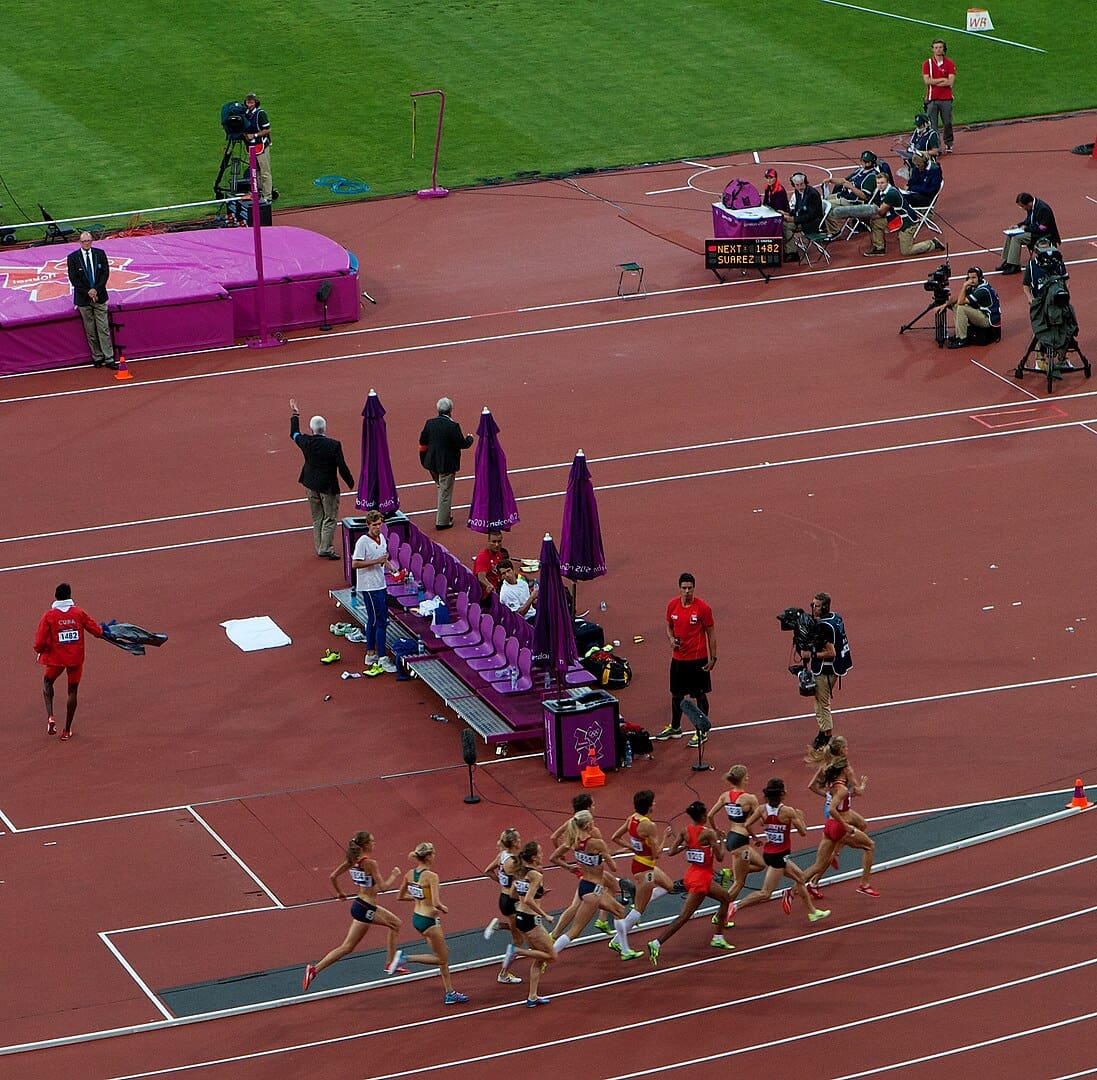
Thomas Brasington from London, england, CC BY-SA 2.0, via Wikimedia Commons
Together, the Summer and Winter Olympics feature 448 events that represent the highest level of athletic accomplishment. With its varied schedule, the Summer Olympics feature 339 events across a wide range of disciplines.
On the other hand, there are 109 events in the Winter Olympics, which emphasize cold-weather sports. With a platform for athletes from all over the world to compete at the highest level in sports ranging from track and field to snow and ice disciplines, this extensive diversity underlines the attractiveness of the Games on a worldwide scale.
29. The 2020 Olympics Added 5 New Sports to the Schedule
With the addition of five new sports to the schedule, excitement was added for the 2020 Tokyo Olympics. With their Olympic debuts, sports like karate, baseball/softball, sport climbing, skateboarding, and surfing enhanced the international sporting event. In addition to broadening the Games’ diversity, this inclusion welcomed new competitors to the Olympic stage to display their skills and brought exciting new elements to the biggest sporting event in the world.
30. Jesse Owens Winning 4 Golds in 1936 Shattered Hitler’s Image of Aryan Supremacy
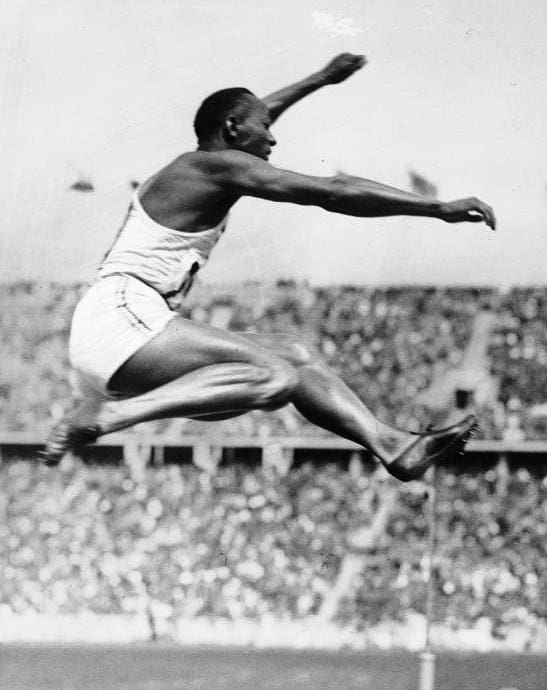
Bundesarchiv, Bild 183-R96374 / CC-BY-SA 3.0, CC BY-SA 3.0 DE, via Wikimedia Commons
At the 1936 Berlin Olympics, Jesse Owens emerged as a symbol of triumph, a historic defiance of Adolf Hitler’s ideal of Aryan supremacy. By winning four gold medals, the African-American long jumper and sprinter dispelled racial stereotypes and undermined Nazi ideology. Through his remarkable accomplishments, which not only demonstrated his extraordinary athletic ability but also spoke out against prejudice, Owens left a lasting impression on the Games and went beyond sports to become a potent symbol of equality and resiliency.
31. The Winter Olympics were First Held in 1924 in Chamonix
The world saw its first celebration of cold-weather sports in 1924 when the Winter Olympics were introduced in Chamonix, France. The event, which started modestly with six disciplines, set the stage for the rich history of the Winter Games.
The Chamonix Olympics established the standard for the ensuing iterations of the tournament, from ice hockey to figure skating. This exhibited the skill of winter sportsmen and provided a stage for the greatest athletes in the world to battle in the icy arenas.
32. Norwegian Biathlete Ole Einar Bjoerndalen has the Most Winter Olympic Medals

Wikijunkie, CC BY-SA 3.0, via Wikimedia Commons
With an astounding 13 medals won, Norwegian biathlete Ole Einar Bjoerndalen holds the record for most Winter Olympics medals. His outstanding accomplishments span several Games, from 1994 to 2014, during which he demonstrated amazing stamina and competence in biathlon competitions. As one of the greatest Winter Olympians, Bjoerndalen’s unmatched success solidifies his reputation, and his contributions to the sport have made a lasting impression on the history of the Games.
33. The USA Boycotted the 1980 Moscow Olympics over the Soviet Invasion of Afghanistan
The 1980 Moscow Olympics were boycotted by the United States in a historic and controversial decision to denounce the Soviet Union’s invasion of Afghanistan. President Jimmy Carter spearheaded the decision, which resulted in the boycott being joined by more than 60 countries, making significant athletes’ absence from the Games unusual. In addition to leaving a lasting impression on the world of sports, the boycott profoundly altered the dynamics of the Olympic movement by acting as a powerful vehicle for expressing political unrest throughout the world during the Cold War.
34. China Won its First Olympic Gold Medal in 1984

kremlin.ru, CC BY 4.0, via Wikimedia Commons
After winning its first gold medal in the Olympics in 1984, China started to rise in the sport. The country’s athletes have proven their extraordinary talent over the years, leading up to a spectacular show in 2008 when Beijing hosted the Games.
China emerged as a sporting superpower, collecting the second-highest number of gold medals. During the quadrennial celebration of world sportsmanship, China’s revolutionary journey reflects the country’s devotion to athletic achievement and its potential to leave a lasting mark on the global stage.
35. The Smallest Nation to Win an Olympic Medal is the Bahamas
With four medals overall, the Bahamas is the smallest country to have won an Olympic Games. This Caribbean country, however small in size, has had a big influence on the world sporting scene. The Bahamas’ athletes have performed exceptionally well across a range of sports, taking home medals that stand for their commitment, skill, and the country’s capacity to compete at the top level on the Olympic stage.
36. Olympic Athletes Cannot Promote any Brand, Company, or Sponsors at the Games
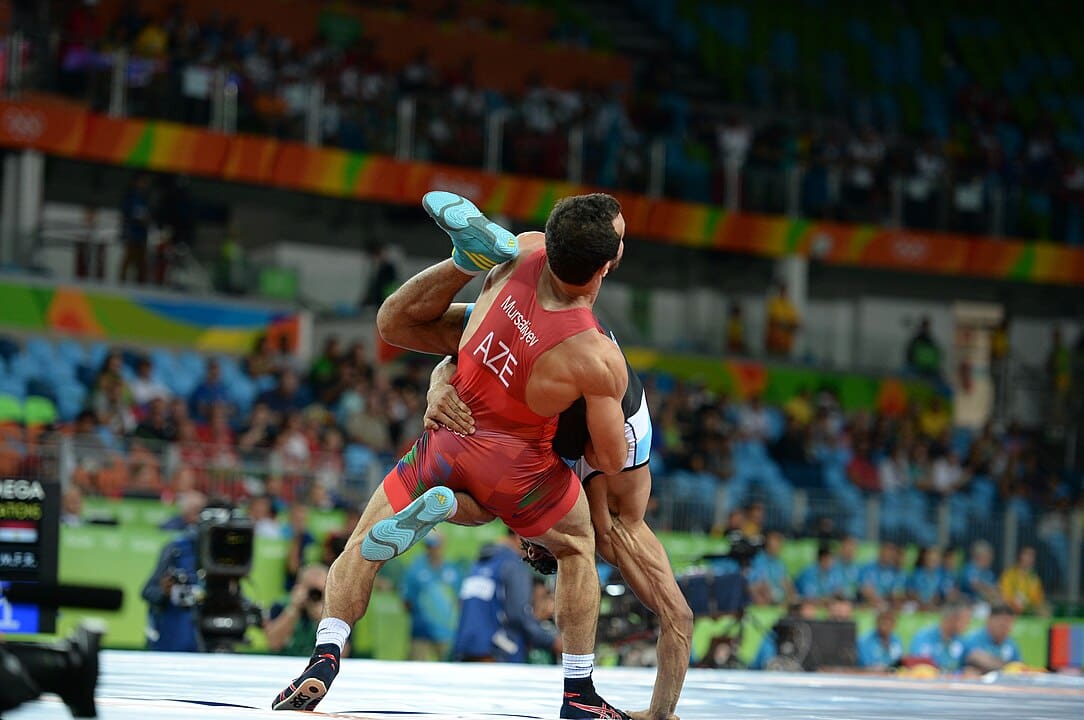
Ilgar Jafarov, CC BY-SA 4.0, via Wikimedia Commons
Strict guidelines set forth by the International Olympic Committee (IOC) restrict athletes competing in the Games from endorsing any firm, sponsor, or brand during the competition. The goal of this law is to uphold the Olympic Games’ neutrality and integrity by promoting fair competition free from outside commercial interference. During the Olympic competition, athletes are expected to maintain a singular concentration on their sporting accomplishments, creating an environment where the quest for greatness is paramount and unhindered by other endorsements or affiliations.
37. Montreal’s 1976 Summer Games left the City with $2 Billion in Debt
The 1976 Summer Olympics in Montreal were a momentous occasion, but they also had a long-lasting financial impact. It would take the city over three decades to pay back the enormous $2 billion debt that it incurred.
A financial strain that affected Montreal’s finances for years was brought on by the enormous costs of hosting the Olympics in addition to other economic difficulties. This story serves as a warning about the careful balance that host towns must strike to make sure that the advantages of hosting the Games outweigh any potential financial difficulties.
38. Tokyo Built the World’s Largest Olympic Stadium for the 1964 Games
Japan built the biggest Olympic stadium in the world, which could hold 70,000 spectators, for the 1964 Tokyo Olympics. In addition to housing the various events, this enormous engineering and architectural marvel represented Japan’s post-war comeback. With an enduring impact on both the history of the city and the Olympic legacy overall, the stadium’s magnificence demonstrated Tokyo’s dedication to demonstrating the Olympic Games’ global relevance.
39. Olympic Host Cities Rarely Recoup Their Massive Investments from Hosting

Johan5885, CC0, via Wikimedia Commons
The financial benefits for host cities are frequently elusive, even though hosting the Olympics requires significant investments in venues, infrastructure, and logistics. It is difficult for host cities to recover their initial expenditures because of the massive costs of the Games in addition to maintenance costs after the event.
The economic impact is yet unknown despite the prominence and international exposure. Discussions over the viability and long-term advantages of hosting the Olympic spectacle are continuing strong because many host cities struggle financially long after the Games end.
40. Russia was Banned from the 2022 Winter Olympics over Doping Violations
Due to continuous doping offenses, Russia suffered a major defeat when it was disqualified from the 2022 Winter Olympics. This ruling prohibited Russian athletes from competing under their national flag and was the result of several doping-related scandals.
As a sign of the International Olympic Committee’s dedication to maintaining integrity and fair play, qualified athletes may instead compete as neutrals. The ban brought attention to the continued problems with doping in sports and the strict controls put in place to protect the integrity and legitimacy of the Olympic Games.
Since its inception in ancient Greece, the Olympic Games have grown to become an international event. The trip through time unveils unexpected information that highlights the cultural, political, and social significance of the Games. Through the common language of sports, the Olympics continue to captivate and unify the world, exhibiting the eternal spirit of competition and friendship from ancient traditions to contemporary controversies.
Planning a trip to Paris ? Get ready !
These are Amazon’s best-selling travel products that you may need for coming to Paris.
Bookstore
- The best travel book : Rick Steves – Paris 2023 – Learn more here
- Fodor’s Paris 2024 – Learn more here
Travel Gear
- Venture Pal Lightweight Backpack – Learn more here
- Samsonite Winfield 2 28″ Luggage – Learn more here
- Swig Savvy’s Stainless Steel Insulated Water Bottle – Learn more here
Check Amazon’s best-seller list for the most popular travel accessories. We sometimes read this list just to find out what new travel products people are buying.









